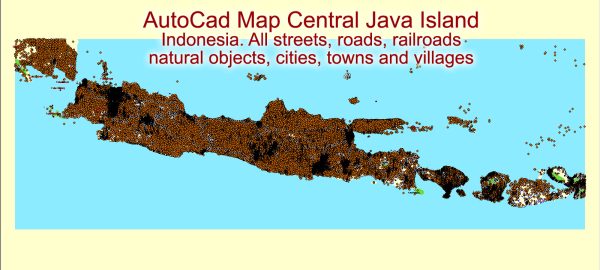Java is the most populous island in Indonesia and has a rich history of urban development that dates back centuries. Here is a brief description of key periods in Java’s urban development:
- Pre-colonial Era: Before the arrival of European powers, Java was home to several powerful kingdoms, including the Majapahit Empire (1293-1500) and Srivijaya. These kingdoms had well-developed urban centers with advanced architecture, irrigation systems, and trade networks.
- Colonial Period: The Dutch East India Company (VOC) established control over Java in the early 17th century. Under Dutch colonial rule, urban development was influenced by European architectural styles. Batavia (now Jakarta), Semarang, and Surabaya became significant Dutch colonial cities, with distinct European and indigenous quarters.
- Japanese Occupation (1942-1945): During World War II, Java was occupied by the Japanese. The Japanese administration made some changes to urban planning and infrastructure.
- Post-Independence Period: After gaining independence in 1945, Indonesia embarked on a process of nation-building. Urban development became a crucial aspect of modernization efforts. Jakarta, as the capital, witnessed rapid urbanization and development.
- Industrialization and Urbanization: In the latter half of the 20th century, industrialization led to increased urbanization. Cities expanded, and new industrial centers emerged, transforming the socio-economic landscape.
- Urban Challenges: Like many rapidly developing regions, Java faces challenges related to urbanization, such as traffic congestion, inadequate infrastructure, environmental issues, and housing shortages. Jakarta, being the capital and one of the most populous cities in the world, has been particularly affected by these challenges.
- Government Initiatives: The Indonesian government has implemented various initiatives to address urban challenges and promote sustainable urban development. This includes efforts to improve infrastructure, transportation, and housing.
- Cultural and Historical Preservation: Efforts have been made to preserve and showcase Java’s rich cultural and historical heritage within urban areas. This includes the conservation of historical sites, traditional markets, and the promotion of cultural events.
It’s important to consult more recent sources for the latest information on Java’s urban development, as the island continues to undergo changes and faces new challenges in the 21st century.


 Author: Kirill Shrayber, Ph.D.
Author: Kirill Shrayber, Ph.D.